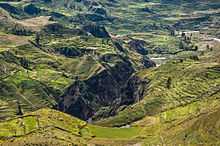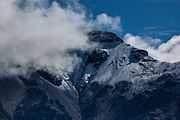Colca Canyon
Coordinates: 15°35′50″S 71°52′45″W / 15.59722°S 71.87917°W

Colca Canyon is a canyon of the Colca River in southern Peru, located about 100 miles (160 kilometers) northwest of Arequipa. It is Peru's third most-visited tourist destination with about 120,000 visitors annually.[1] With a depth of 13,650 ft (4,160 m), it is more than twice as deep as the Grand Canyon in the United States. The Colca Valley is a colorful Andean valley with pre-Inca roots, and towns founded in Spanish colonial times, still inhabited by people of the Collagua and the Cabana cultures. The local people maintain their ancestral traditions and continue to cultivate the pre-Inca stepped terraces.
History
The Quechua-speaking Cabanas, probably descended from the Wari culture, and the Aymara-speaking Collaguas, who moved to the area from the Lake Titicaca region, inhabited the valley in the pre-Inca era. The Inca probably arrived in the Colca Valley around 1320 AD, and established their dominion through marriage, rather than through warfare. The Spaniards, under Gonzalo Pizarro, arrived in 1540 and in the 1570s the Spanish viceroy Francisco de Toledo ordered the inhabitants to leave their scattered settlements and to move to a series of centrally located pueblos, which remain the principal towns of the valley. Franciscan missionaries built the first chapel in the valley in 1565, and the first church in 1569.
No passable roads existed between Arequipa and Chivay until the 1940s, when a road was completed to serve the silver and copper mines of the region. More roads were built in the 1970s and 1980s by the Majes Hydroelectric Project, a program to divert water from the Colca River to irrigate crops in the Majes region. Access today is usually via Arequipa.
In May 1981, the Polish Canoandes rafting expedition made the first descent of the river below Cabanaconde, and proclaimed the possibility of its being the world's deepest canyon. It was so recognized by the Guinness Book of Records in 1986, and a National Geographic article in January 1993 repeated the claim.[citation needed] The joint Polish/Peruvian "Cañon del Colca 2005" expedition verified the altitudes of the river and the surrounding heights via GPS.
Tourism has increased since the 1980s and 1990s from a few thousand visitors annually to nearly 150,000 visitors in 2010.[citation needed]
Geography
Colca-Arequipa 14 plains of Majes, it is known as the Majes River, and then is known as the Camana before reaching the Pacific Ocean at the town of that name. Within the province of Caylloma it is known as the "Colca Valley" between Callalli and Pinchollo/Madrigal. Down to Huambo it is known as the Colca Canyon. The town of Chivay is located at the midpoint of the Colca valley. Above Chivay, at an elevation of 12,000 ft (3,650 m), agriculture gives way to livestock raising, principally alpacas and llamas, with some sheep and dairy cattle as well. Below Chivay the valley presents intensely terraced landscapes, continuing for many kilometers downstream. Within the deepening valley downriver, a series of small villages is spread out over the approximately 35 miles (56 km) between Chivay and the village of Cabanaconde. The canyon reaches its greatest depth in the region of Huambo, where the river has an elevation of 3,497 ft (1,066 m). In contrast, about 15 miles (24 km) to the southeast of Cabanaconde rises the 20,630 ft (6,288 m) high Ampato, a snow-capped extinct volcano.
Attractions
The canyon is home to the Andean Condor (Vultur gryphus), a species that has been the focus of worldwide conservation efforts. The condors can be seen at close range as they fly past the canyon walls, and are a popular attraction. 'Cruz del Condor' is a popular tourist stop to view the condors. At this point the canyon floor is 3,960 feet (1,200 m) below the rim of the canyon.
Other notable bird species present in the Colca include the Giant Colibri, the largest member of the hummingbird family, as well as the Andean Goose, Chilean Flamingo, and Mountain Caracara. Animals include vizcacha, a rabbit-sized relative of the chinchilla, zorrino, deer, fox, and vicuña, the wild ancestor of the alpaca.
The La Calera natural hot springs are located at Chivay, the biggest town in the Colca Canyon. Other hot springs, some developed for tourist use, are dotted throughout the valley and canyon.
Archeological sites include the caves of Mollepunko above Callalli where rock art (said to be 6,000 years old) depicts the domestication of the alpaca; the mummy of Paraqra, above Sibayo; the Fortaleza de Chimpa, a reconstructed mountaintop citadel that looks down on Madrigal; ruins of pre-Hispanic settlements throughout the valley; and many others.
Cultural attractions include the Wititi festival in Chivay, named as a "cultural heritage" of Peru. The Colca is also well known for crafts: goods knitted from baby alpaca fiber and a unique form of embroidery that adorns skirts (polleras), hats, vests, and other items of daily wear and use.
The most distant source of Amazon River is accessible from the Colca valley via Tuti, a one-day trip to a spring at 16,800 feet (5,120 m), where snowmelt from the Mismi bursts from a rock face. Other attractions include the Infiernillo Geyser, on the flanks of the volcano Wallqa Wallqa, which is accessible on foot, horseback, or mountain bicycle, and a number of casas vivenciales where tourists can stay with a local family in their home and share in their daily activities.
Autocolca, an autonomous authority created by law in the 1980s, is responsible for tourism promotion and management in the Colca Valley.
Gallery

|
References
See also
External links
| Wikimedia Commons has media related to Colca Valley. |
- Official Site Colca Canyon
-
 Colca Canyon travel guide from Wikivoyage
Colca Canyon travel guide from Wikivoyage - Peru Cultural Society - Colca Canyon




